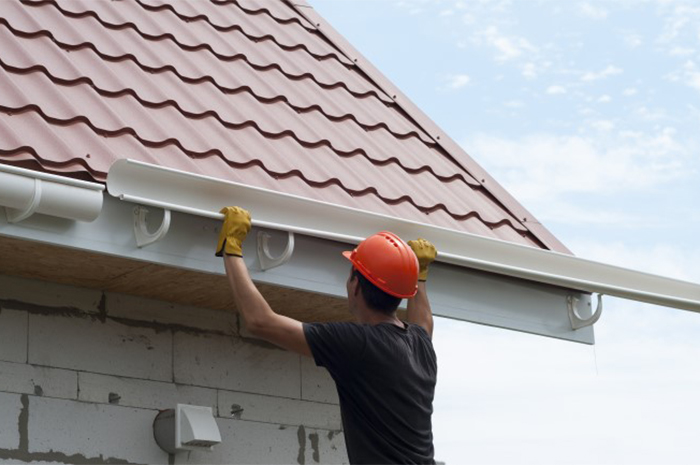This is How to Install the Correct Metal Gutters So Rain Water Doesn't Damage Buildings

Gutters are part of the building's drainage system which functions as a reservoir for rainwater that falls from the roof to be channeled into gutters, reservoirs, or infiltration wells. Without gutters, rainwater can fall where it is not wanted, so it has the potential to seep and damage building walls, foundations, and so on. Installation of gutters must be done properly in order to function properly. Likewise with metal gutters or metal gutters. Then how do you install metal gutters correctly? Here's how:
Get to know Gutter Metal
There are many types of materials for gutters, such as cast concrete, plastic (PVC), fiberglass, and metal (metal). There are also many types of metal gutters, including zinc, galvalum, mild steel, copper, or a combination thereof. Rainbow will discuss metal gutters that are produced with a knock down system that are ready to be applied to buildings. Ready-to-install metal gutters are semi-circular or square in shape, and are made of strong, durable, and anti-rust galvanized coated mild steel. Usually also equipped with powder coating paint.
Preparation Before Installation
For metal knock down gutter applications, do the following preparations.
First, calculate the need for flat gutters (water overflow reservoir). Calculations can be made from working drawings (roof plans) or by directly measuring the length of the side of the roof to be fitted with gutters (roof circumference). Please allow 1-3 meters tolerance. Also calculate the need for accessories or various complements below.
- Gutter angle, namely the part of the gutter that is installed at the corners of the roof. Count the number of angles around the roof including the outside and inside corners.
- Overflow restraint, to hold back the flow that is too heavy so it does not overflow out of the gutters (usually at the corners of the roof).
- Hangers (gutter mounts) are ideally installed per 1 meter distance. So, the calculation is equal to the total length of the gutter + 1.
- Spacer, serves to straighten the position of the hanger if the lisplank is not perpendicular. Provide a number of hanger spacers.
- Gutter connector, serves to unite the gutters as well as anticipate leaks that may occur at the meeting point of the gutters. Needs adjusted number of connections.
- Chamfer cover, which serves as a cover for each end of the gutter. Count the ends of the chamfer to find the amount needed.
- Funnel and standpipe. The function of the funnel is to funnel water from the gutter to the standpipe, which will drain it to the waste. Ideally the distance between funnels (also standpipes) is ±6-10 meters. The length of the pipe per rod is 3 meters. The length per one standpipe is calculated according to the height of the wall and the distance of the funnel to the wall. The total length is the length of the standpipe multiplied by the number of standpipes to be installed. While the need for funnels is the number of upright pipes multiplied by 2.
- Curved pipe, to connect the funnel and standpipe. The amount is adjusted by the number of funnels or standpipes multiplied by 2.
- Pipe holder, used to hold the pipe to the wall so it doesn't shift or wobble. Ideally, pipe supports are installed per 2 meters of pipe length. Or, according to conditions.
- Pipe shoes, installed at the lower end of the pipe to direct the water flow to the waste. The amount corresponds to the number of standpipes. This element can be replaced with a curved pipe.
- Screws and sealant (special adhesive). The amount is adjusted as needed.
Second, prepare various equipment for measurement and installation. Some of the main tools are a tape measure, pencil, thread, waterpass or water hose, zinc scissors, hacksaw, electric drill equipped with a screwdriver, ladder, and K3 equipment.
Third, determine the position and slope of the gutter, then mark it with a pencil or thread. The slope of the gutter affects the smooth flow of water from the gutter to the standpipe below. Ideal slope of 1% (height difference of ±1 cm for every 1 meter distance) to 3%. Use a level or water hose to determine the slope. Next mark the points where the gutter hangers need to be attached.
How to Install Metal Gutters
Broadly speaking, the installation of metal gutters includes the following stages.
• Install gutter hangers. For buildings without skirting boards, install gutter hangers along the walls below the eaves. For buildings with lisplank, gutter hangers are attached to the lisplank with the help of spacers. First attach the gutter hangers to the spacers with screws. Next, screw the top of the spacer on the trim (if necessary, bend the spacer to the slope of the trim).
• Install all gutter hangers at predetermined points by following the slope made. Review the preparation steps again.
• Install the gutter connector, by attaching it to the top of the gutter with the meeting point as the axle. Use sealant to seal the gap.
• Apply the funnel at predetermined points. Previously, make a hole in the part of the gutter where you want to install the funnel. Use sealant to seal the gap.
• Cut the vertical pipe according to the height of the wall; and a connecting pipe according to the distance from the wall to the funnel. Then, attach the pipe and connect it to the funnel with the help of a curved pipe. Use sealant to seal the gap.
• Install all accessories, such as pipe supports, pipe shoes, gutter covers, and so on. Double check any cracks and seal with sealant.
That's all, and I hope this review is useful.
